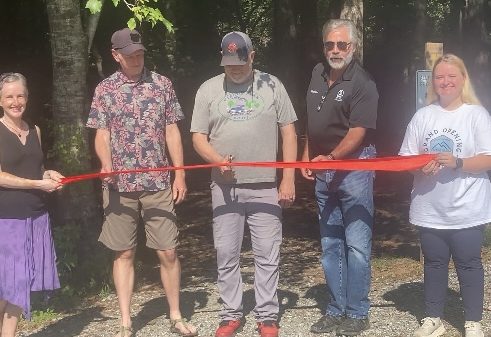“Please don’t move my rocks,” says the hellbender
Published 11:07 am Friday, October 20, 2023
|
Getting your Trinity Audio player ready...
|
Have you heard of a hellbender? And if not, just what is one? How about the longest salamander in the US, growing up to two and a half feet long? You’ve got to be kidding. Nope, they are huge!
And where do they live? Right here in our western North Carolina streams and all along the Eastern seaboard from New York to Alabama. They are very secretive which adds to their mystique.
But let’s start at the beginning. This mysterious amphibian been around 160 million years, which puts it on Earth about the same time as the dinosaurs.
You may have heard of them by some of their nicknames like snot otter, because they are slimy, or lasagna sides, because of the ripples along their body. No matter what we call them, they are fascinating creatures and are the species that started Dale (Weiler) and me on our conservation journey.
When we saw a photo of rocks stacked in a stream on Facebook, we thought they looked cool. But then we learned that hellbenders live under rocks in streams. If you move the rocks, as in stacking them, the hellbender could lose its home and possibly die. But since we had no idea what a hellbender was, we figured we better do some research.
And here is what we learned. Hellbenders spend their entire lives in the water, and they breathe through their skin. Those ripples I mentioned earlier help them breathe. Streams must be really clean for hellbenders to survive, hence they are known as an indicator species. You won’t find hellbenders if the stream is polluted or silted up.
While females lay their eggs under rocks (another reason not to move them), the males guard the eggs until they hatch about 6 to 8 weeks later. Now, sometimes if the males get hungry, they eat the eggs, but generally, they are protective of them.
So what do they eat? Some of their favorite foods are crayfish, insects and small fish. And what eats them? Once they reach adulthood, they don’t have many predators. While still young they might be eaten by birds of prey, raccoons and otters, and sometimes big fish or snakes.
After learning so much about them and even visiting the WNC Nature Center to meet Meatloaf, their resident hellbender, we fell in love with these cool animals. Kinda like how Dale and I got engaged in 8 days, but I digress.
Fast forward six years, and Dale has created two hellbender sculptures, one of which is at the North Carolina Zoo’s hellbender habitat. We now have a nonprofit organization inspiring kids to fall in love with wildlife and habitat, including the hellbender! Our motto; the more you learn, the more you love, the more you protect!
And hellbenders need our help. Their populations are threatened primarily due to habitat destruction and stream pollution caused by humans.
But you can help. First, please don’t be a hellbender homewrecker and stack rocks. Tell folks about the amazing hellbender. Visit our Western NC National parks like Pisgah National Forest, where you might spot one in the wild, or see one at the many zoos and wildlife centers that have hellbenders. And I vote for them as one of the coolest animals on the planet, by far!
Loti Woods is a founder of Champions for Wildlife, a nonprofit organization whose mission is to inspire and empower the next generation to be champions for wildlife using art and education. To learn more, visit championsforwildlife.org.






